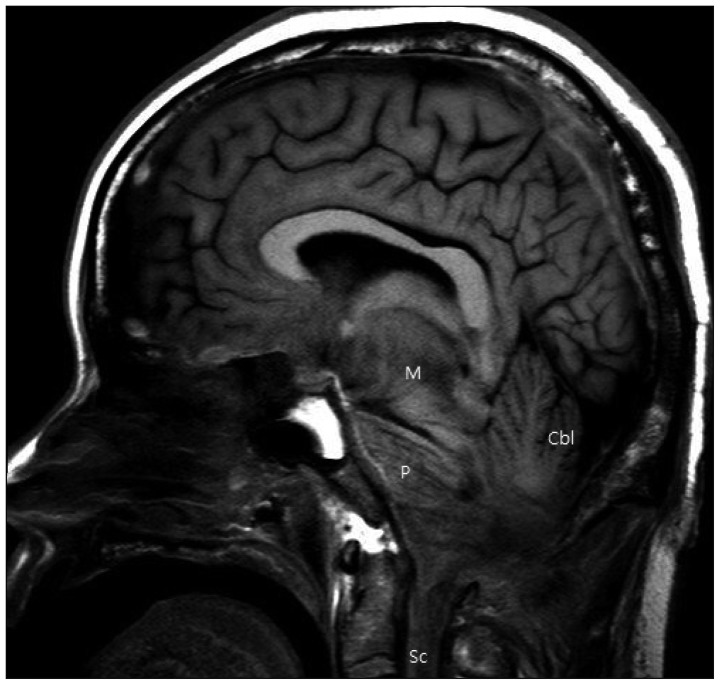J Korean Neurosurg Soc.
2014 Dec;56(6):534-536. 10.3340/jkns.2014.56.6.534.
Pontomedullary Laceration, a Fatal Consequence of Skull Base Ring Fracture
- Affiliations
-
- 1Department of Neurosurgery, Haeundae Paik Hospital, Inje University College of Medicine, Busan, Korea. jheaj@paik.ac.kr
- KMID: 2191154
- DOI: http://doi.org/10.3340/jkns.2014.56.6.534
Abstract
- Due to improvements in emergency resuscitation provided by rescue teams, more trauma victims who could have died due to sudden heart failure at the scene are brought to the hospital following resuscitation. Most of these patients present with major organ injuries and hypovolemic shock at the time of trauma. However, head trauma associated with sudden heart arrest is rare. Here, we report a case of ring fracture with pontomedullary laceration that led to sudden heart arrest.
Keyword
MeSH Terms
Figure
Reference
-
1. Byard RW, Langlois N, Gilbert JD. Positive "water test"-an external indicator of base of skull hinge-ring fracture. J Forensic Sci. 2010; 55:519–520. PMID: 20102468.
Article2. Carter DA, Mehelas TJ, Savolaine ER, Dougherty LS. Basal skull fracture with traumatic polycranial neuropathy and occluded left carotid artery : significance of fractures along the course of the carotid artery. J Trauma. 1998; 44:230–235. PMID: 9464783.
Article3. Gan YC, Charkravarty D, Flint G. Ring fracture of the skull base : case report and review of the literature. Br J Neurosurg. 2002; 16:300–303. PMID: 12201403.
Article4. Gunji H, Mizusawa I, Hiraiwa K. The mechanism underlying the occurrence of traumatic brainstem lesions in victims of traffic accidents. Leg Med (Tokyo). 2002; 4:84–89. PMID: 12935674.
Article5. Kahl JE, Calvo RY, Sise MJ, Sise CB, Thorndike JF, Shackford SR. The changing nature of death on the trauma service. J Trauma Acute Care Surg. 2013; 75:195–201. PMID: 23823614.
Article6. Kondo T, Saito K, Nishigami J, Ohshima T. Fatal injuries of the brain stem and/or upper cervical spinal cord in traffic accidents : nine autopsy cases. Sci Justice. 1995; 35:197–201. PMID: 7663992.
Article7. Konrad CJ, Fieber TS, Schuepfer GK, Gerber HR. Are fractures of the base of the skull influenced by the mass of the protective helmet? A retrospective study in fatally injured motorcyclists. J Trauma. 1996; 41:854–858. PMID: 8913216.
Article8. Ohshima T, Kondo T. Forensic pathological observations on fatal injuries to the brain stem and/or upper cervical spinal cord in traffic accidents. J Clin Forensic Med. 1998; 5:129–134. PMID: 15335533.
Article9. Pfeifer R, Tarkin IS, Rocos B, Pape HC. Patterns of mortality and causes of death in polytrauma patients--has anything changed? Injury. 2009; 40:907–911. PMID: 19540488.
Article10. Zachariades N, Mezitis M, Mourouzis C, Papadakis D, Spanou A. Fractures of the mandibular condyle : a review of 466 cases. Literature review, reflections on treatment and proposals. J Craniomaxillofac Surg. 2006; 34:421–432. PMID: 17055280.
Article11. Zhu BL, Quan L, Ishida K, Taniguchi M, Oritani S, Fujita MQ, et al. Longitudinal brainstem laceration associated with complex basilar skull fractures due to a fall : an autopsy case. Forensic Sci Int. 2002; 126:40–42. PMID: 11955830.
Article12. Zivković V, Nikolić S, Babić D, Juković F. The significance of pontomedullar laceration in car occupants following frontal collisions : a retrospective autopsy study. Forensic Sci Int. 2010; 202:13–16. PMID: 20439142.
- Full Text Links
- Actions
-
Cited
- CITED
-
- Close
- Share
- Similar articles
-
- Traumatic Blindness Due to Injury of Internal Carotid Artery Associated with Craniomaxillofacial Fracture
- Radiologic investigation of growing skull fracture
- Iatrogenic Skull Base Defect Accompanied by Brain Injury After Endoscopic Sinus Surgery: A Report of Two Cases
- A Case of Traumatic Bilateral Abducens Nerve Palsy Associated with Skull Base Fracture
- Transcondylar Approach to Skull Base Lesions



